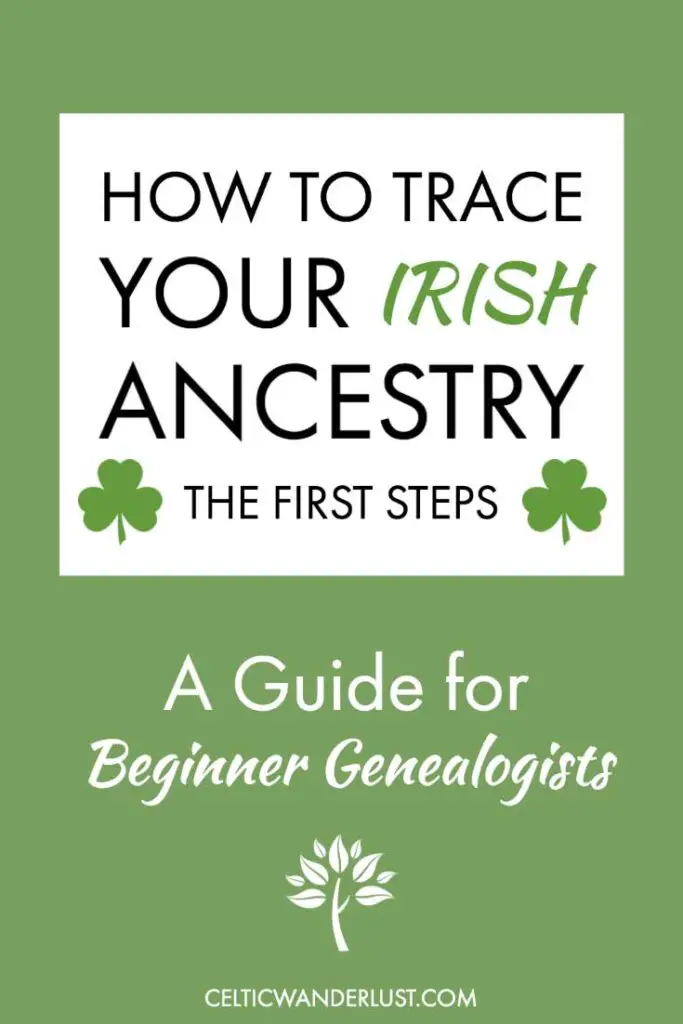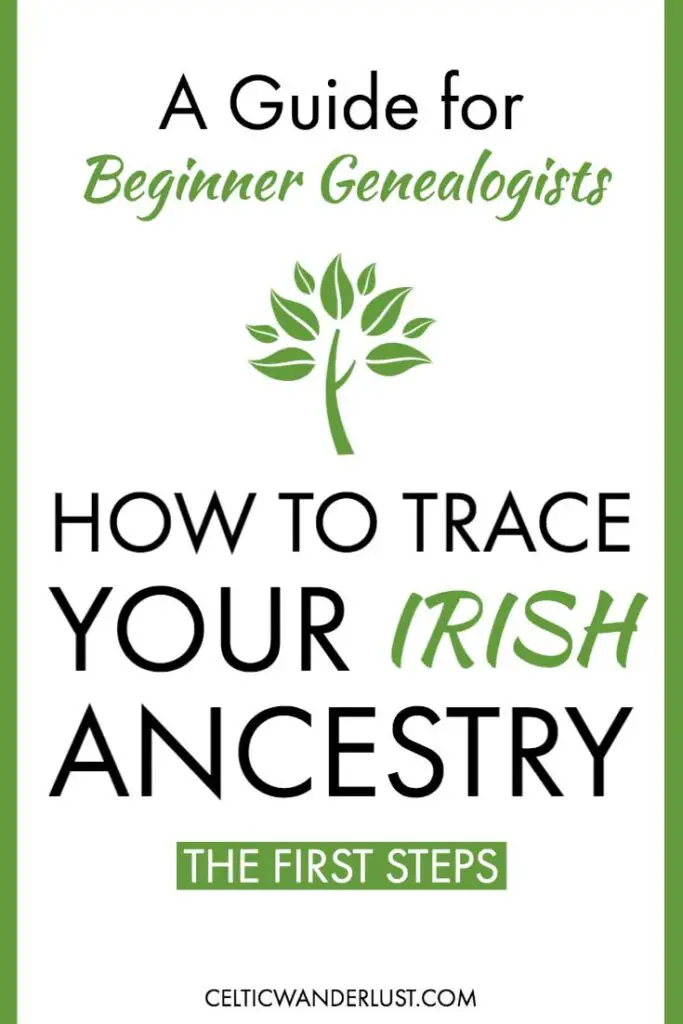How to Trace Your Irish Ancestry: the First Steps
You are lucky enough to be Irish, or from Irish heritage, and you want to know more about your Irish ancestry. The task of researching your Irish family history is exciting but can also feel overwhelming at times. You might not know how and where to start your research. Fret not! This article is here to guide your first steps in tracing your Irish family tree.
If you are new to genealogy, I would also recommend having a look at my post “How to Get You Started the Right Way” for tips on making the most of your research. Defining your goal is one tip I would definitely encourage you to follow before taking the plunge.


What do you know about your Irish Ancestry?
First thing’s first. Before you even start digging into genealogy records, you need to recap what you and the people around you know about your family. You and your family members are your very first source of information. It’s time to grab your favourite pen and notebook (or computer) and start writing down facts and memories about your ancestors.
Start with Yourself
Start writing down information that you know and heard about your ancestors. The most relevant information that you need to collect at this stage are names, dates and places of birth, marriage and death. You can also record details related to burial, baptism, education and career.
These are just a starting point. If you can think of any other relevant information, go ahead and put it on paper. It could be useful later on.
Do you have any documents or family photos in your possession? Maybe you have old certificates, diaries, letters or postcards. They all contain clues about your ancestors, where and when they lived, if they emigrated. Family bibles were often used to record births and deaths; look for notes in the margins.
Interview Family Members and Friends
Then come family members. Have a chat with the oldest members of your family, they are your most valuable sources of information. Old family legends might come up. Don’t dismiss them straight away, a seed of truth might be hidden in the story.
Interview everyone in your family who wants to get involved. They might even carry out some research for you and dig up more information and evidence about your family tree like old family albums or certificates.
Family friends are not to be forgotten in the process. They too may have information about your ancestry. They may have heard old stories or even witnessed key events like marriages or burials of family members. Write down these interviews or even tape them for transcribing.
Understand your Irish Surname
Now that you have collected all the information you could from your relatives, take some time to figure out the most obvious element of your Irish identity: your surname. It might reveal clues about your very first ancestor and where your family first originated from.
Figure Out the Meaning of Your Irish Surname
Surnames were not always used and not always passed on from generation to generation. Surnames started to become hereditary for some ruling families in Ireland in the 12th century while the rest of the population didn’t need one until the 15th century.
The Common Origins of Irish Surnames
Understanding your Irish surname is to understand how it was formed. Irish surnames, like in the rest of Europe, have five common origins:
- a location (ex: Sutton), even though this is quite rare in Ireland,
- a profession (ex: McGowans, meaning “son of the smith”),
- a descriptive (ex: Dunn, meaning “dark” or “brown”),
- a parent (ex: McKay, meaning “son of Aodh”) or
- a descendant (ex: O’Byrne, meaning descendant of Bran, a mythological figure).
What about your surname? Have you figured it out yet?
The prefixes “Mac” and “O” in Irish Surnames
As we all know, some Irish names share a very distinctive characteristic: the prefix “mac” or “mc”, meaning “son of”, or instead the prefix “o” which translates as “grandson of” or “descended from”.
The prefix can be followed either by the name of a profession, a popular given name, a famous ancestor or even a Saint. The female version “nic” meaning “daughter of” can also be found. O’Clery is the earliest surname recorded in Ireland. In the 10th century, this person was the descendant of a clerk.
The Outside Influences Shaping Irish Surnames
Irish surnames were influenced and shaped by several influxes of people along the centuries, diversifying the pool of names in existence and bearing the trace of Ireland’s complex history.
The Vikings, who periodically looted Irish lands and even settled on the island in the 9th century, for instance gave Ireland the name Doyle meaning “the dark foreigners”. The Norman invasion in the 12th century introduced the prefix “fitz” found for example in Fitzgerald meaning “son of Gerald”.
The plantations of the 16th and 17th centuries saw the introduction of Scottish names like Stewart and Campbell while the Cromwellian conquest brought English names like Bewley and Goodbody to Ireland.
To help you unlock its meaning, try searching for your name on the website Behind The Name, a very handy database of names and their origin.
Understanding the origin of your Irish surname can give you clues about your very first ancestor. Were they an artisan, a member of a clan, a saint’s devotee or just tall? It can also reveal a more complex origin beyond the lands of Ireland. Your ancestor might have been originally from France or Scotland before settling in Ireland.
List the Variants of Your Irish Surname
Maybe you have already realised that spellings of names are not set in stone. Your ancestors’ surnames could have changed over time and for different reasons. Trying to work out your name’s different spellings is a common problem faced by genealogists but with Irish surnames comes a different challenge: anglicization.
The anglicization of Irish Surnames
With Ireland under the control of England for centuries, the English influence left its mark on Irish surnames. The most significant one was the prefixes “Mac” and “O” being dropped. Families reinstated their prefix later on but for some the prefix was gone for ever.
With anglicization, some families had their names transformed beyond recognition. The name Murphy, the anglicized form of the Irish name Ó Murchadha, is a perfect example of that.
Your ancestors might have used the Irish version of their anglicized surname, or even both, in official records. To find out about the spelling of your Irish surname, Behind The Name is again a great resource. It also provides a list of variants that may be useful for your research.
Changes in Spelling
A common issue that every genealogist has to face is the change of spelling. The spelling of a surname can change for numerous reasons. It could be because of illiteracy, the difference in pronunciation, a government or church scribe writing it down the way they think it should spelt.
Another reason would have been the Irish immigration. People emigrating from Ireland, possibly illiterate, speaking only Irish or a broken English, had to register their names with local officials on arrival. So much could have gone wrong with the spelling. Some even changed their name completely to start fresh in a new country or hide from their past.
Before rushing into your research, take some time to think about all the different spellings your name could have and make a list. Websites like FamilySearch and WeRelate record closely related surnames based on phonetics. Try searching for your family name and see what variants come out.
Online Genealogy Research: Where to Start
Once you have gathered all you could from interviews and found out about the origin and all the different spellings of your name, it is time to have a first look at the main resources available to you online.
Commercial Genealogy Websites
Websites monetizing the access to genealogy records have flourished in recent years. Signing up is free, but you will have to pay a fee or subscribe monthly to be able to view for instance a birth or death certificate you might be interested in. Sites like Ancestry, FamilySearch, FindMyPast or MyHeritage are among the most popular ones.
These genealogy websites can be very valuable especially if you are not located in Ireland, or don’t know someone in the country to access historical records for you.
Having said that, you might want to keep your money and just use these websites to point you in the right direction. You might not be able to view a birth or marriage certificate but some valuable information can be sometimes accessed for free.
For example FamilySearch allows you to search historical records freely and view the transcribed information without paying a fee. You can also view the 1911 Ireland Census on MyHeritage for free. So give them a try, you don’t know what exciting clues you could find!
Free Genealogy Websites
There are free genealogy websites out there that you can use for your research. They are collaborative websites, like giant family trees, where people like you can share information about their ancestors with other hobby genealogists.
Unlike commercial genealogy websites where the same person can appear on several family trees created by individual members, collaborative websites work like wikis. Each person has their own page that can be updated by any members if they have more information to provide regarding this ancestor.
WeRelate and WikiTree are two of these free genealogy websites worth a visit. You don’t even have to sign up if you just want to search for your ancestor. People wanting to share their own findings have to follow strict rules and indicate their sources to ensure the highest quality of the information provided. Have a look, you might find one of your ancestors.
Irish Genealogy Records
Some Irish records can be accessed online for free and you might even find free websites where it is possible to search specific databases. The abundance of resources can be overwhelming so as a beginner genealogist it is best to start searching the following records.
Census Records
Census records from 1821 to 1911 can be viewed on the National Archives of Ireland website. Records have been transcribed so you don’t have to try deciphering old handwriting by yourself. But if you really want to see the original document, know that it is also available to view for free.
Catholic Parish Registers
Catholic parish registers have been digitised and are available to view for free on the National Library of Ireland website. You will find records of baptisms and marriages for Ireland, North and South, for the 19th century.
The trick is that you need to know the parish where the event took place and go through pages and pages of scanned documents. A real detective work! There are gaps in the collection unfortunately but these registers are a prime source of information.
Civil and Church Records
The Irish government has set up a website that allows to search Civil and Church Records online for free. Irishgenealogy.ie is your go-to website for searching civil marriages, births and deaths in Ireland from the mid 19th century to the mid 20th century. Information has been transcribed but you can also view the original document on your screen.
Records from the Roman Catholic Church and the Church of Ireland were also made available on the same website. You can search baptism, marriage and burial records for free. Information has also been transcribed but you can also view the Church Register page by clicking the link at the bottom of your screen.
With a multitude of sources available, tracing your Irish family tree can quickly become an overwhelming affair. To keep the fun in genealogy, I chose to adopt an organised approach that I hope will help you put together your Irish family history, starting with these first few steps. Enjoy the search!
RELATED POSTS


Leave a Reply